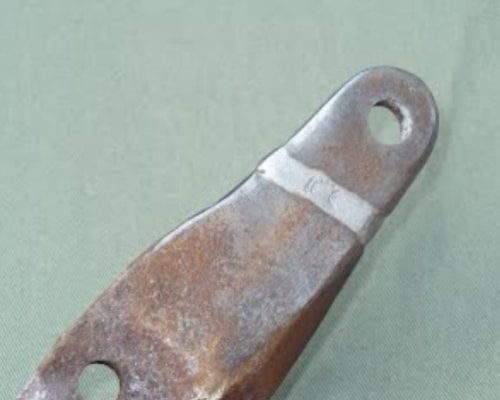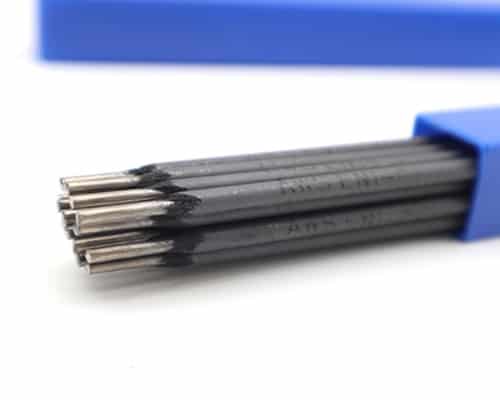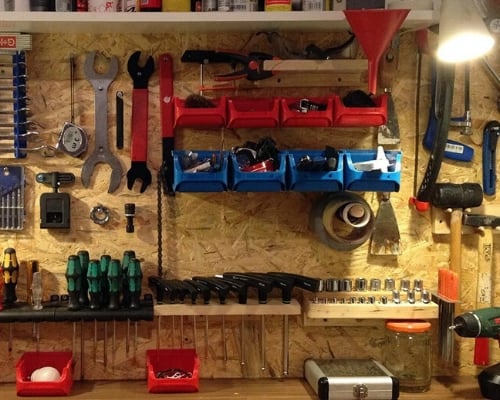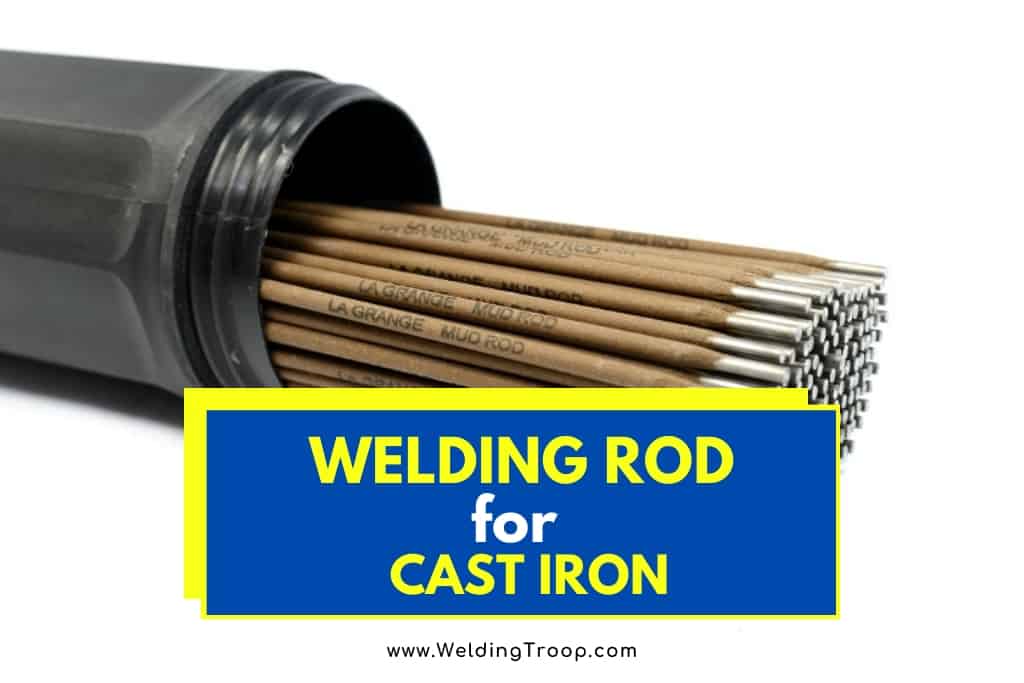Cast iron is everywhere. It is used for decorated objects around the home and in the garden. Many automotive parts are made from cast iron. Most pump housings are made from cast iron. What happens when that cast-iron cracks or breaks? Is it a total loss, or can it be welded successfully to create a repair? If so, what type of welding rod should you use to affect a welded repair on the cast iron?
What welding rod to use for cast iron? There are three options when selecting a welding rod for cast iron. Each welding rod will make a good weld but may have different characteristics during and after the weld. The three choices are:
| Options Nr. | Welding rod for cast iron |
| 1 | Nickel Allow Rods |
| 2 | Cast Iron Covered Rods |
| 3 | Steel Rods |
Making that repair on your broken or cracked cast iron part is not beyond the capability of a home or hobby shop welder.
There are some tricks and tips to both choosing a welding rod and making the repair weld that doesn’t involve any special equipment or training.
Proper preparation and at least a little understanding of cast iron can make the process well worth the effort. Below are some types of welding rods to do the right job.
Related reading: How To Successfully Weld Cast Iron?
Table of Contents
Understanding Cast Iron
Cast iron is a term that gets tossed around a lot when people start talking about metal, but few really understand cast iron and its peculiarities. Understanding a little about the types of cast iron and how they differ can make a big difference in how you approach making a welded repair on a cracked or broken piece.

Before you continue reading, here is an article we wrote about the time it take to learn welding
The Chemistry
Cast iron is alloy contrary to what a lot of people believe. Cast iron is made by melting pig-iron and adding alloying materials such as:
- chromium
- Molybdenum
- Copper
- Titanium
- Vanadium
Once one of these alloys is used, silicon is added. The differing alloying material affects the grain structure of the cast iron and its ductility and machinability.
The Cast Iron Lineup
Cast iron is typically classified into four categories or types. It is imperative to understand the characteristics of each type of cast iron before you choose a welding rod and start welding.
Gray Cast Iron
Gray cast iron is probably the most common type of cast iron in use. The microstructure of gray cast iron is dominated by graphite in the microstructure of the metal. This produces a cast iron that:
- Is more ductile and weldable than other types of cast iron
- Has good machinability
- Offers good resistance to wear
On the downside, the graphite content of the cast iron can pose problems if they get into the weld pool. This contamination by the graphite can make the weld brittle and prone to cracking.
White Cast Iron
White cast iron retains the carbon content as iron carbide instead of graphite. This gives the white cast iron remarkably high compressive strength and hardness. The hardness contributes to excellent resistance to wear but also means that white cast iron is almost impossible to weld successfully.
Ductile Cast Iron
By adding small amounts of magnesium and cesium to gray cast iron during the furnace melting, the graphite is gathered in nodules that become almost immobile in the metal. This also creates a cast iron with higher strength and higher ductility. Like the gray cast iron from which it is derived, ductile cast iron can be welded
Malleable Cast Iron
Heat treating white cast iron creates a metal with higher ductility but retains most of the characteristics of the original metal. This heat-treated white cast iron is classified as malleable cast iron. It cannot be welded successfully without destroying some of the characteristics of the malleable cast iron and turning the areas in and around the weld into gray cast iron.
Choose your Welding Rod
- Nickel Alloy – From the three choices, we listed above of welding rods that work best to weld cast iron, the preferred rods are those with high nickel content. Many of these rods will contain as much as 99% nickel alloy. This makes them expensive, so many welders opt for a less costly option. If machining is required after welding, nickel alloy rods are the preferred choice.
- Cast Iron Covered Rods – These rods are commonly available and can give extremely good welds that are ductile and machinable. The welds made with cast iron covered rods tend to be easier to clean as well but more attention has to be made to preparation and pre-heating.
- Steel Rods – Steel rods can be used to weld cast iron, but they produce hard welds that are not machinable. This makes the weld hard to clean as well. However, the low cost makes them popular.

However, for the home hobby welder, buying one or two of the more expensive nickel rods to make a small repair may not involve that much expense.
Steel rods and cast iron covered rods will work but may take more effort and may not produce a weld that is as easy to machine or clean after the welding is one.
There are many welding rod manufacturers, and they all offer a variety of welding rods with metal content and coatings for almost any application. Asking a local welder who has experience in working with cast iron is always a good plan. Practical experience and recommendations are often more informative than the technical specification sheets that the manufacturers provide.
Before you Strike an Arc
Welding cast iron is as much about the preparation as it about making the weld. There are certain things that need to happen before the actual weld is applied and then immediately after the weld to prevent warping or cracking of the cast iron part.
Clean the Casting
It doesn’t make much difference in the alloys used in making the cast iron. The cast iron piece must be cleaned and prepared before welding can begin. All surface contamination must be removed from the cast iron in the area of the weld. You must clean the cast iron surface down to the metal surface, removing any contaminants, grease, paint, or other foreign material.
After the surface in the area of the weld is cleaned, moderate heat should be applied for a short time. This will open the pores of the metal and alloy any trapped gas to escape. Any impurities on the surface of the metal or trapped gas in the metal will cause your welds to be porous and brittle.
Preheat
Cast iron tends to crack when put under stress. You may have already experienced this if the cast iron piece on which you about to weld has a crack. Welding imposes heat stress on any metal. As you heat the metal to the fusion point, the surrounding area that isn’t being heated tries to contain the expansion of the area where the heat is applied, and cracks can occur.
Heat control is the best way to prevent cracking in cast iron while you are welding. This involves preheating the area to be welded to allow the metal to control the thermal expansion of the metal.
Heating the area around the weld zone allows more even expansion as the weld is accomplished. The area to be welded and the adjacent areas should be preheated to at least 250 degrees F.
Welding
You should weld with as little heat as possible. This is generally accomplished by using the lowest current setting possible approved by the manufacturer of the welding rods. Keeping the arc aimed at the weld pool rather than the base metal can also help with localized heating.
Related Article: What Types of Gas Welding Are Commonly Used? | Are they popular?
Control the Cooling
Controlling the post-weld cool-down period is as important as pre-heating before the weld. Thermal contraction in the metal starts as soon as the arc is extinguished.
Compression forces can build as the metal cools down unevenly, which can result in cracking. Peening, a method of striking the still deformable weld with a hammer, can help reduce the risk of cracking.
Adding insulating material to the weld and the cast iron piece can slow the cooling process, and even adding heat back to the weld to slow the cooling process as much as possible will also help prevent cracking or deformation.
In the Home Shop!
With a little skill and by following a few simple steps, it is possible to weld cast iron. Understanding the material, choosing the right rod, and following the right steps in the welding process will result in a successful repair on the broken or cracked cast iron project.
Learn More About PPE – Personal Protective Equipment – Here, you can find an article from our website about: Personal Protective Equipment for Welders – PPE | List, and Requirements

Recommended Reading
Do Welders Get Drug Tested? | All Facts You Need To Know
Does Welding Hurt Your Eyes? How Can You Protect Your Eyes

